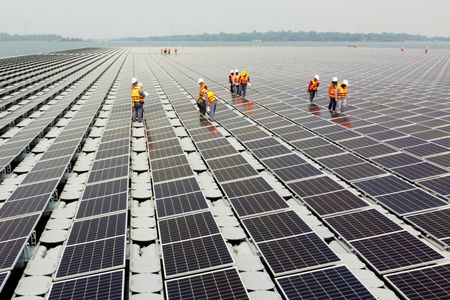By Sudarshan Varadhan
SINGAPORE (Reuters) -Cambodia plans to boost its capacity to import clean power from neighbouring Laos, Vietnam and Thailand by more than 600 megawatts, its energy minister told Reuters, a more than 50% uplift to currently agreed deals.
Keo Rottanak said the move highlighted the potential for boosting interconnection in southeast Asia, and said it provided more options to diversify power supply amid rising volatility in hydropower output due to weather-related disruptions.
He said the imports will supplement power supply in “areas where there are environmental or financial benefits”, but said the bulk of Cambodia’s energy will still be generated domestically. The southeast Asian nation recently approved 23 domestic power projects worth $5.7 billion, he said.
Cambodia will import 300 MW of solar and hydro capacity from Laos starting in 2026, is in the final stages of approval to almost double a 300 MW import deal with Vietnam, and could potentially import another 100 MW from Thailand, Rottanak said.
The 300 MW hydro and solar deal with Laos was signed last week and is “going to come to Cambodia in 2026,” Rottanak told Reuters in an interview at Singapore International Energy Week.
Cambodia currently has contracts to import 1,030 MW of power from Thailand, Vietnam, and Laos, according to the U.S. International Trade Administration, accounting for nearly a quarter of its total power capacity.
Imports from Vietnam are set to begin “as soon as possible”, as the Cambodian and Vietnamese national electric utilities have already wrapped up discussions on the deal and are waiting for final government approvals, he said.
The full contracted import capacity may not be used if domestic supply is enough to meet Cambodia’s needs, Rottanak said, adding that imports would not exceed 25% of total generation at any given time.
“For example, now we have good rains and imports are almost zero,” he said.
The 10-member Association of Southeast Asian Nations (ASEAN) has been trying for decades to form a regional grid to facilitate multilateral power trade, but progress has been limited to bilateral deals.
Rottanak said he expects the regional grid to become a reality by 2035, adding that Cambodia’s energy policy was an example of how grid interconnection can be beneficial.
(Reporting by Sudarshan Varadhan; Editing by Sharon Singleton and Jan Harvey)











